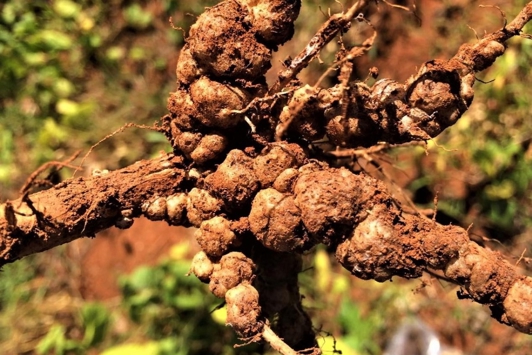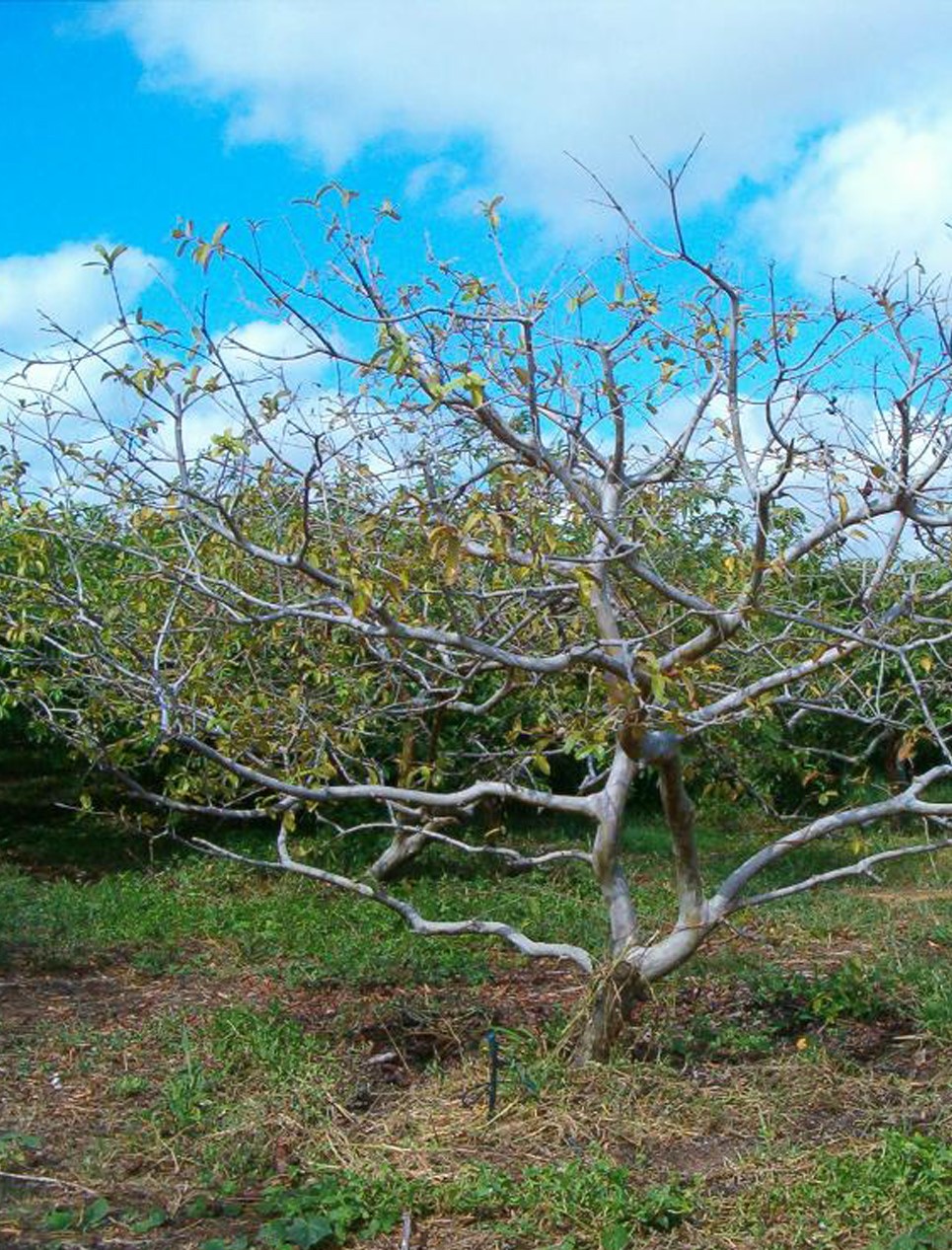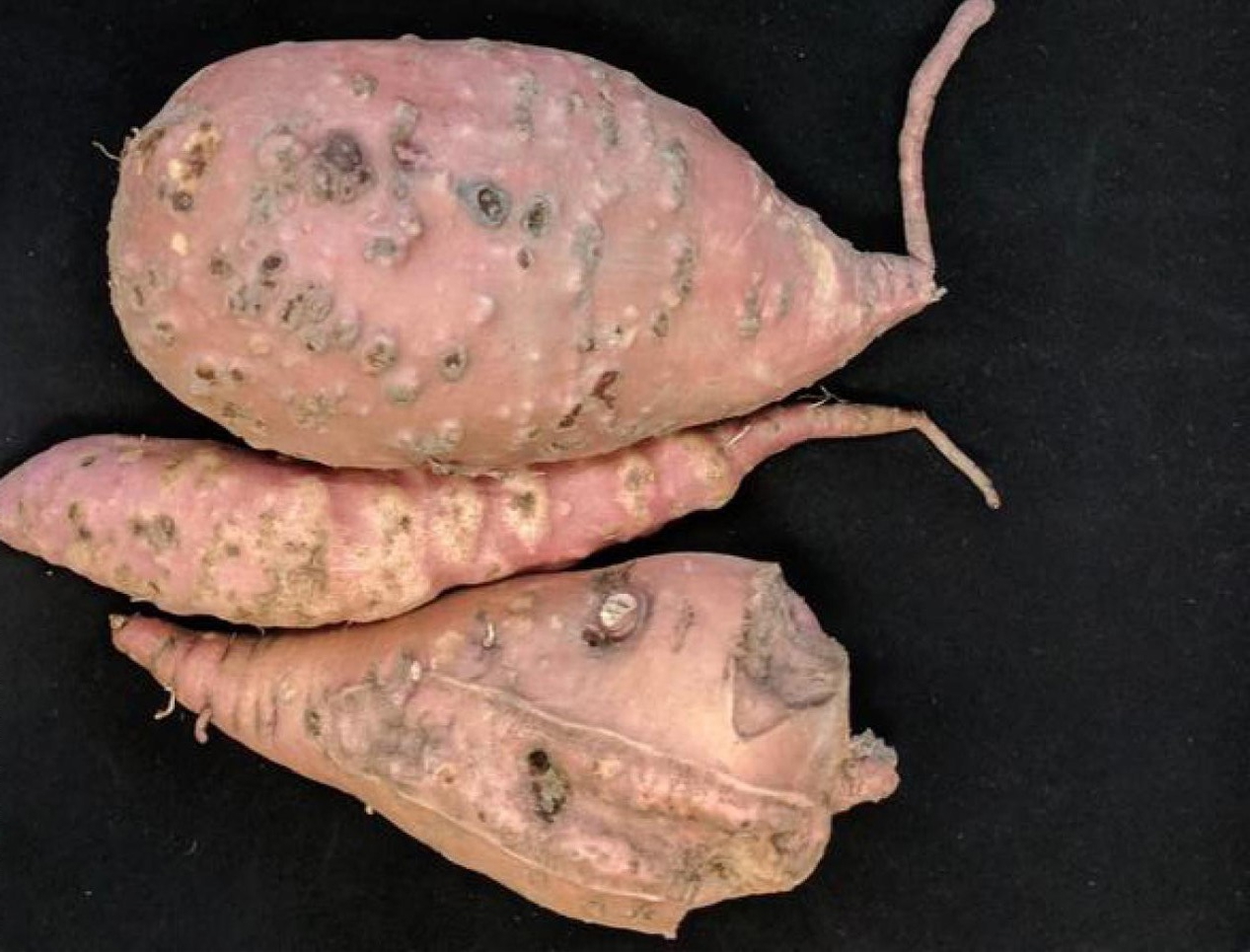Guava root-knot nematode (Meloidogyne enterolobii), also known as GRKN, is a microscopic plant parasitic nematode that infects below-ground tissues of a broad range of crops and ornamental plants. Infection disrupts the plant's normal growth indirectly affecting plant yield in some hosts, and directly affecting production for root and tuber crops.
Vegetables: significant hosts include bean, capsicum, chilli, cucumber, eggplant, potato, pumpkin, snake bean, soybean, sweet potato, tomato, and zucchini.
Other plants: basil, banana, cotton, ginger, guava, papaya, watermelon, ornamental plants and some weed species.
Below-ground
- galls (knotty growths) on the roots, rhizomes, bulbs or tubers of infected plants
- large sized galls in severe infections
- deformed tubers with large galls, a dark and cracked surface in root vegetables.
Above-ground (symptoms may resemble water and nutrient stress)
- wilting plants and stunted growth
- leaf yellowing or dull colour
- reduced flowering and fruit setting
- plant death in severe infestations.
Affected roots may present very large galls.

Photo – © 2019 Rodrigo Vieira da Silva, Instituto Federal Goiano, Campus Morrinhos, Goias, Brazil
Abnormal branching, as in the guava tree below

Photo – © 2010 Dr. Regina Carneiro, Embrapa Recursos Geneticos e Biotecnologia – CENARGEN Brasilia, DF, Brazil - gt.eppo.int
Badly affected root tissue in tubers

Photo – © 2010 Camilo Parada and Dr. Lina Quesada, NC State Vegetable Pathology Lab - gd.eppo.int)
- Significant damage to crops and plants is due to high population density because it can also reproduce in alternate hosts, including weedy species, and has a high reproduction rate.
- The formation of galls or knots causes significant damage to root tissues which disrupts the plant's normal growth and functions, resulting in reduced plant growth and yield, and even plant death in severe cases.
- It can also infect edible underground plant parts like rhizomes (for example, ginger), swollen roots (e.g. sweet potatoes), and tubers (e.g. potatoes). These can be severely deformed with large galls, a dark and cracked surface, resulting in reduction of plant produce quality and quantity.
- Root-knot nematodes feed on root tissues.
- Juvenile nematodes hatch from eggs in roots or in the soil and migrate in the soil to roots of susceptible hosts where they feed and develop into adults.
- Female root-knot nematode become sedentary, feed in a location within a root and produce eggs.
- The nematodes survive the winter primarily as eggs attached to females either on roots, tubers or in the soil.
- Eggs can survive in the soil (without a host) for up to 12 months, making control difficult.
- A nematode generally moves a very limited distance on its own, at most to a few tens of centimetres in the soil, while it can be transmitted via irrigation water and flooding.
- It can be spread over larger distances by people moving:
- plants and seedlings with infested roots, and below ground vegetables (bulbs, tubers, corms, rhizomes),
- infested growing media/soils, or infested soils attached to below ground vegetables, machineries, tools and footwear.
Western Australia's freedom from guava root-knot nematode is supported by general and specific surveillance, and specific import requirements to prevent its entry. A person who finds or suspects the presence of guava root knot-nematode in plantations, nurseries or urban areas must report it to the department.
Legal duty to report
Guava root-knot nematode is not known to occur in WA.
Meloidogyne enterolobii (Yang & Eisenback, 1983) is a declared pest under section 12 of the Biosecurity and Agriculture Management Act 2007.
This means that any person who finds or suspects the presence of guava root-knot nematode must report it to the department.
Report suspected guava root-knot nematode
Early detection and reporting will help protect WA horticulture.
If you find or suspect the presence of guava root-knot nematode, report it in one of the following ways.
Note: Do not disturb the plant. Do not move, compost, or dispose of suspect plants.
Related content
- Biosecurity and Agriculture Management Act 2007
- Guava root-knot nematode | Business Queensland (business.qld.gov.au)
- Guava root-knot nematode | Northern Territory (nt.gov.au)
- Guava root-knot nematode: biosecurity alert (470 KB)pdf
- Pest and Disease Information Service (PaDIS)
- Potato Industry Biosecurity Plan | AUSVEG (ausveg.com.au)
- Western Australian Organism List (WAOL)
